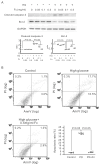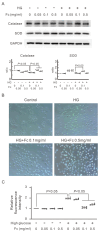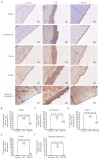Therapeutic Potential of Oligo-Fucoidan in Mitigating Peritoneal Dialysis-Associated Fibrosis
- PMID: 39728104
- PMCID: PMC11678284
- DOI: 10.3390/md22120529
Therapeutic Potential of Oligo-Fucoidan in Mitigating Peritoneal Dialysis-Associated Fibrosis
Abstract
Peritoneal dialysis (PD) serves as a home-based kidney replacement therapy with increasing utilization across the globe. However, long-term use of high-glucose-based PD solution incites repeated peritoneal injury and inevitable peritoneal fibrosis, thus compromising treatment efficacy and resulting in ultrafiltration failure eventually. In the present study, we utilized human mesothelial MeT-5A cells for the in vitro experiments and a PD mouse model for in vivo validation to study the pathophysiological mechanisms underneath PD-associated peritoneal fibrosis. High-glucose PD solution (Dianeal 4.25%, Baxter) increased protein expression of mesothelial-mesenchymal transition (MMT) markers, such as N-cadherin and α-SMA in MeT-5A cells, whereas it decreased catalase expression and stimulated the production of reactive oxygen species (ROS). Furthermore, macrophage influx and increased serum pro-inflammatory cytokines, such as IL-1β, MCP-1, and TNF-α, were observed in the PD mouse model. Interestingly, we discovered that oligo-fucoidan, an oligosaccharide extract from brown seaweed, successfully prevented PD-associated peritoneal thickening and fibrosis through antioxidant effect, downregulation of MMT markers, and attenuation of peritoneal and systemic inflammation. Hence, oligo-fucoidan has the potential to be developed into a novel preventive strategy for PD-associated peritoneal fibrosis.
Keywords: MMT; fibrosis; mesothelial–mesenchymal transition; oligo-fucoidan; peritoneal dialysis.
Conflict of interest statement
The authors declare no conflicts of interest. The funders had no role in the design of the study; in the collection, analyses, or interpretation of data; in the writing of the manuscript; or in the decision to publish the results.
Figures






Similar articles
-
Pressure induces peritoneal fibrosis and inflammation through CD44 signaling.Ren Fail. 2024 Dec;46(2):2384586. doi: 10.1080/0886022X.2024.2384586. Epub 2024 Jul 31. Ren Fail. 2024. PMID: 39082695 Free PMC article.
-
Empagliflozin attenuates epithelial-to-mesenchymal transition through senescence in peritoneal dialysis.Am J Physiol Renal Physiol. 2024 Sep 1;327(3):F363-F372. doi: 10.1152/ajprenal.00028.2024. Epub 2024 Jul 4. Am J Physiol Renal Physiol. 2024. PMID: 38961839
-
Caffeic acid phenethyl ester restores mitochondrial homeostasis against peritoneal fibrosis induced by peritoneal dialysis through the AMPK/SIRT1 pathway.Ren Fail. 2024 Dec;46(1):2350235. doi: 10.1080/0886022X.2024.2350235. Epub 2024 May 9. Ren Fail. 2024. PMID: 38721924 Free PMC article.
-
Fibrosis of Peritoneal Membrane as Target of New Therapies in Peritoneal Dialysis.Int J Mol Sci. 2022 Apr 27;23(9):4831. doi: 10.3390/ijms23094831. Int J Mol Sci. 2022. PMID: 35563220 Free PMC article. Review.
-
Peritoneal Membrane Preservation.Semin Nephrol. 2017 Jan;37(1):77-92. doi: 10.1016/j.semnephrol.2016.10.009. Semin Nephrol. 2017. PMID: 28153197 Review.
References
-
- Raoofi S., Pashazadeh Kan F., Rafiei S., Hoseinipalangi Z., Rezaei S., Ahmadi S., Masoumi M., Noorani Mejareh Z., Roohravan Benis M., Sharifi A., et al. Hemodialysis and peritoneal dialysis-health-related quality of life: Systematic review plus meta-analysis. BMJ Support. Palliat. Care. 2023;13:365–373. doi: 10.1136/bmjspcare-2021-003182. - DOI - PubMed
MeSH terms
Substances
Grants and funding
LinkOut - more resources
Full Text Sources
Research Materials
Miscellaneous

